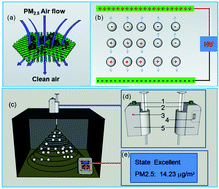Chitosan nanostructures by in situ electrospinning for high-efficiency PM2.5 capture
Abstract
Nanofiber-based air filters and electrostatic precipitation have stimulated considerable interest because of their high-efficiency for PM2.5 capture. In this paper, we introduce a new method of in situ electrospinning (e-spinning) of nanostructures into a polluted enclosed space to efficiently clean the air. From the comparisons of different polymer precursors and different PM2.5 capture techniques, it can be seen that in situ e-spinning of chitosan aqueous solution into the air exhibits the best PM2.5 capture efficiency, which may be attributed to the stronger polarity of chitosan and the synergistic effect of the strong electrostatic adsorption and surface adhesion of the electrospun (e-spun) nanofibers. A removal rate as high as 3.7 μg m−3 s−1 was obtained using this technology with a high efficiency of more than 95% PM2.5 capture. The results obtained from a field test in a smoking room (∼5 × 6 × 3 m3) are still in great agreement with those obtained in an experimental box (∼25 × 30 × 35 cm3). More importantly, chitosan is non-toxic and biodegradable, and is harmless to human health when used as a precursor for in situ e-spinning for PM2.5 capture.



 Please wait while we load your content...
Please wait while we load your content...